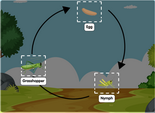Stingray Facts, Science Game for Kids
This science game will help kids learn and master key facts about the stingray.
The Life of the Stingray, and Its Similarities with Sharks
A group of sea rays known as stingrays is made up cartilaginous fish that are closely related to sharks. Learn more about the life cycle of the stingray, and the similarities between it and sharks. Find out more about the life cycle of the Stingray, its physical characteristics and our article on the similarities between sharks and the Stingray. You will be glad that you did. These are some facts about the Stingray. This fascinating animal is amazing! If you love the ocean, this is a must-see!
The lifestyles and Life cycle of Stingray
Round stingrays have short movements and periods of inactivity. They move at their most active when the water temperature rises by as much as 10 degrees. They could be seeking out more favorable breeding conditions, better foraging success, or potential partners. Although researchers have seen this behavior in the Pacific Ocean and the reasons why it occurs are not clear.
The life expectancy of stingrays varies from one species to the next. A stingray's lifespan is determined by its population size. After a four- to seven-month gestation, southern stingray females give birth to their pups. Females can give birth to as many as 10 pups per litter. The males mature about a year before the female. Southern stingrays are able to reach sexual maturity at around seven years of age. However, the males mature a year earlier. The life expectancy of a stingray can be up to 15 years. The stingray can live alone or with other stingrays. They communicate through touch, biting and pheromones.
Physical characteristics
The bright blue spots on this sea creature are a sign of its venomous spines and tail. The underside of the body has a large flat mouth that is ideal for scooping up sand animals. The shells of crustaceans and fish can be crushed by the two plates at the back of the mouth. Stingrays have strong senses of smell and venom.
The Atlantic stingray prefers warm estuarine and coastal waters. It can tolerate temperatures up to 86° Fahrenheit. They can migrate north or south in certain seasons and exhibit temperature-induced seasonal movements throughout their range. They can be found in the Chesapeake Bay in summer and fall, but they migrate south to warmer waters during winter months. They then migrate back to the surface of water.
Venom
The effects of venom from stingrays on the human body can be varied. Stingray venom can trigger the sensation of 'nociception', which is sensory information that is elicited through tissue damage. These stimuli are sent to the brain by neural cells called nociceptors, which interpret them as pain. The adult stingray's venom is stronger than the juvenile stingray's. It is responsible for activating protein exudation (the release of organic fluids through cell membranes and walls).
Stingray venom contains different protein constituents than those in terrestrial and snake venom. The stingray venom includes hyaluronidase and metalloproteinases. These proteins cause hemorhage and degrade extracellular matrix components. They also affect blood flow. These results are encouraging and could have significant implications for venom therapy.
Similarities to sharks
Many similarities exist between sharks and rays. Both have cartilage skeletons, and gill openings. Both have modified "scales", which are visible on their bodies. These two animals differ in their swimming ability and their breathing patterns. Find out more about the similarities and differences between sharks, stingrays, and other aquatic animals. They are very similar. However, the similarities between sharks and stingrays are striking.
Although both species share similar dorsal surfaces their skins are made of a tough material called shagreen. Their skins look similar to sandpaper but have modified "scales". Both sharks as well as rays can be found in warm and cold waters, which makes them similar in their habitats. Sharks are more endangered that rays, which further complicates the similarities. Both types of rays can be found in the ocean as well as in shallow coastal waters.
Stingray attacks
Although they are usually found on the ocean floor and occasionally come in contact with humans, stingrays can also be found on the ground. Stingrays are not aggressive but will defend themselves if accidentally stepped upon. Sometimes, stingray attacks are caused by incorrect information. To target their prey, stingrays use communication and location surveillance. This article will explain how to protect yourself and your children from stingray attacks.
Stingray attacks in Australia are still rare, although they do happen. A recent study found that a 42-year old Australian swimmer was attacked by a stingray while he was swimming off the coast Tasmania. The stingray didn't kill the 42-year old man, but he suffered a severe heart attack that caused him to drown in the water. The stingray left behind a trail that was bloody and stinging.









